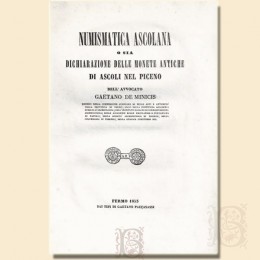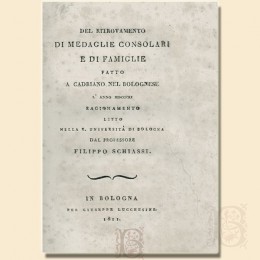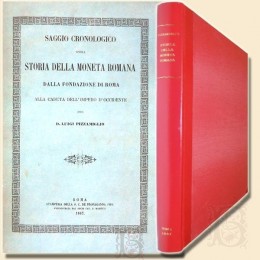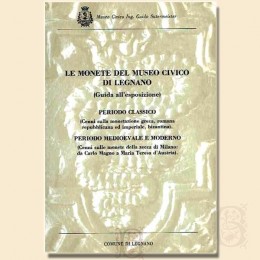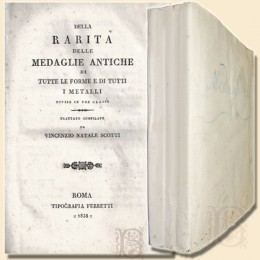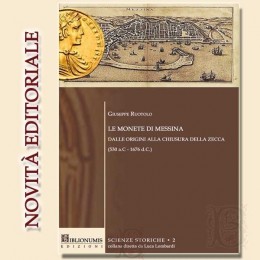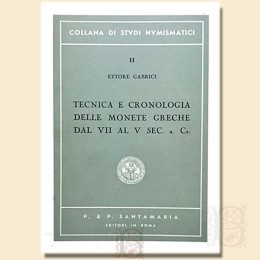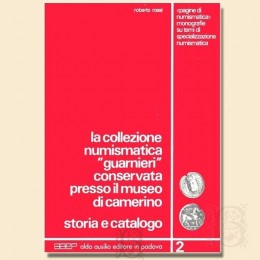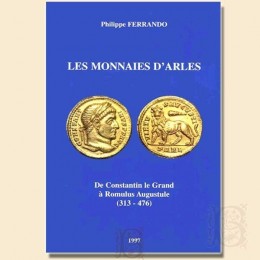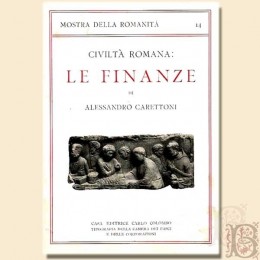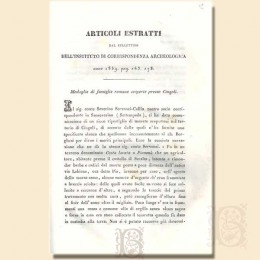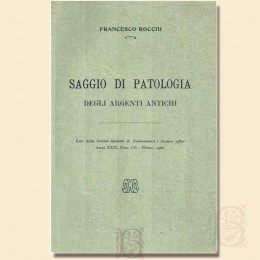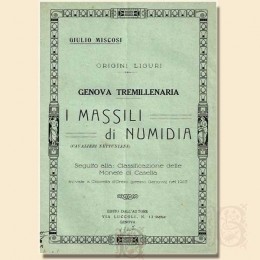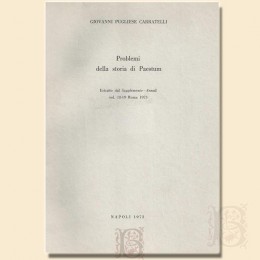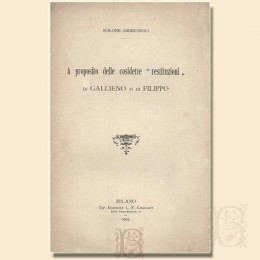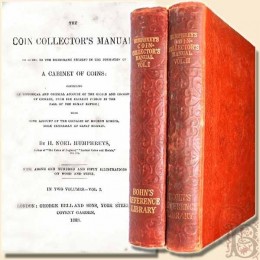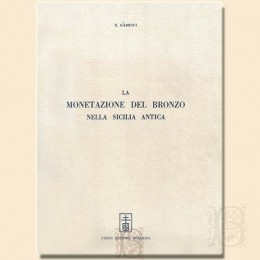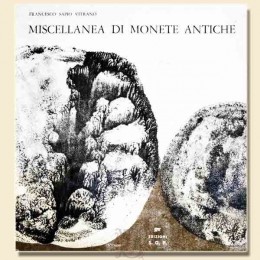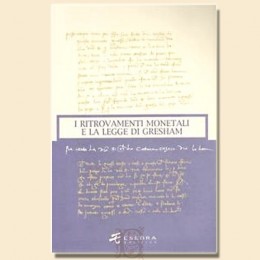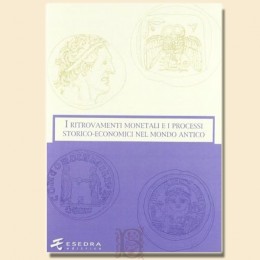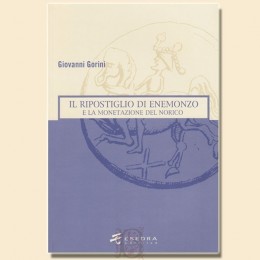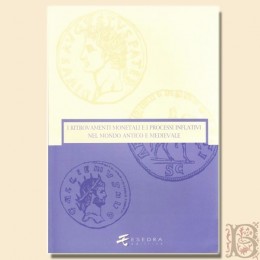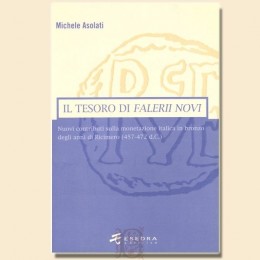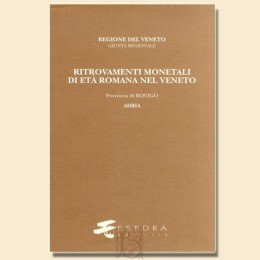Resources
Ancient numismatics
Welcome to the section dedicated to ancient numismatics books of Biblionumis.it, the reference point for enthusiasts and collectors of coins and medals. On the site you will find a wide selection of specialized texts, edited by expert numismatists, that explore the fascinating history of coins from antiquity to the present day. Our books will guide you on a journey through the centuries, telling you the story of ancient civilizations through the evolution of their coins. Whether they are Greek, Roman, Byzantine, modern or contemporary coins, each book is a precious source of knowledge to delve into the historical, artistic and economic details that only numismatics can reveal. We offer works written by internationally renowned numismatists and historians, guaranteeing accurate and detailed content. From coin catalogs with illustrations and detailed descriptions to manuals, each text is designed to satisfy both the expert collector and the novice. You will also find practical guides that will help you evaluate, classify and best preserve your ancient coins. Numismatics is not only a study of the past, but also a current passion that grows every day. Investing in the right books means enriching your knowledge and improving the quality of your collection. Each volume here has been carefully selected to offer you the maximum amount of information and expertise. Our books are essential tools for anyone who wants to delve deeper into ancient numismatics. Thanks to detailed descriptions, high-quality images and contributions from experts, these texts will allow you to navigate the world of ancient coins with confidence. Discover our collection and find the perfect book for you. Whether you are an avid collector or a researcher, our texts will provide you with all the knowledge you need to take your passion for numismatics to the next level. Browse our categories now and enrich your library with fundamental works of ancient numismatics on Biblionumis.it!
-
De Minicis, Numismatics of Ascoli
€220.00Gaetano De Minicis, Numismatics Ascoli or both declaration of the ancient coins of Ascoli in the Piceno, from the types of Gaetano Paccasassi, Fermo 1853, pp. VIII, 72, 2 splendid plates, cm 31, paperback ed. with titles and decorations.
Elegant ex libris on the verso of the last plate.
Small lack on the margins of the editorial paperback, otherwise in excellent condition with fresh paper and wide margins.
Very rare.
-
Schiassi, On the discovery of...
€40.00Filippo Schiassi, On the discovery of consular and family medals made in Cadriano in the Bologna area in the year 1811. Reasoning read in the R. University of Bologna, for Giuseppe Lucchesini, Bologna 1811, pp. 54, 23 cm, br. coeval mute.
Blooms on the first and last card, otherwise in excellent condition and in beards.
Very rare first edition, reprinted in Bologna in 1820.
-
Pizzamiglio, History of Roman coins
€180.00Luigi Pizzamiglio, Chronological essay or History of Roman currency from the foundation of Rome to the fall of the Western Empire, Typography of the SC De Propaganda Fide, Rome 1867, pp. 233, ill., 3 large and splendid tables folded (90x40 cm each) reproducing coins, 32 cm, elegant red half leather binding with titles and decorations in gold on the spine and canvas plates, editorial paperback preserved.
Lossless tear on the inner margin of five papers with old restoration and insignificant traces of use, however overall the work is still intact and in excellent condition.
Rare.
-
Coins from the Museum of Legnano
€35.00Coins from the Civic Museum of Legnano. Exhibition guide. Classical period (hints on Greek, Roman republican and imperial, Byzantine coinage). Medieval and modern period (notes on the coins of the Milan mint: from Charlemagne to Maria Theresa of Austria), edited by N. Vismara, R. Martini, Edizioni Ennerre, Milan 1988, pp. 384, richly illustrated, 24 cm, br. and.
Catalog of the permanent exhibition.
In perfect condition.
-
Scotti, On the rarity of ancient...
€80.00Vincenzo Natale Scotti, On the rarity of ancient medals of all shapes and metals divided into three classes, Ferretti Typography, Rome 1838, pp. 440, 18 cm, coeval waiting paperback, title handwritten in blue pencil on the front cover.
Traces of use on the paperback, otherwise the work is in more than good condition, with large margins.
Rare.
-
Ruotolo, The coins of Messina...
€18.00Giuseppe Ruotolo, The coins of Messina from the origins to the closure of the mint (530 BC - 1676 AD), work published under the aegis of the Mediterranean Society of Numismatic Metrology, Biblionumis Edizioni, Terlizzi 2018, pp. 73, richly illustrated, 21 x 15 cm, editorial paperback, ISBN 978-88-99512-06-4.
Historical Sciences, 2. Series directed by Luca Lombardi.
The author - former president of the Italian Academy of Numismatic Studies for almost three decades, now president of the Mediterranean Society of Numismatic Metrology - synthetically and with scientific rigor analyzes the coins issued in Messina from ancient times to the closure of the Sicilian mint. Taking into account the most recent studies, the monograph opens with historical notes relating to the city, the intense activity of its mint is then presented, which lasted over 22 centuries, starting from the classical era, to then reach Arab, Norman and Swabian domination. , Angevin, Aragonese and Emperor Charles V. The rich iconographic apparatus and the notes accompanying the text are of extreme interest. The work, which constitutes the second volume of the Historical Sciences Series directed by Luca Lombardi, was printed in a limited number of copies and on ivory paper. As proof of the exceptional nature of this publishing event, the publication is made under the aegis of the Mediterranean Society of Numismatic Metrology.
-
Gabrici, Technique and...
€85.00Ettore Gabrici, Technique and chronology of Greek coins from the seventh to the fifth century. to. Cr., P. & P. Santamaria, Rome 1951, pp. 80, richly illustrated, 5 plates, 22 cm, br. and.
Series of numismatic studies, 2.
Elegant ex libris on the title page, handwritten title on the spine.
Insignificant traces of use, however overall in excellent condition.
Very rare.
-
Guarnieri collection
€90.00Roberto Rossi, The Guarnieri numismatic collection kept at the Camerino Museum. History and catalog, Presentation by Franco Panvini Rosati, Aldo Ausilio Editore, Padua 1979, pp. 147, richly illustrated, 24 cm, br. and.
Series: Pages of numismatics. Monographs on numismatic specialization issues, 2.
The volume contains the catalog of an important collection of ancient coins kept first at the Valentiniana Library in Camerino, then at the Civic Museum of Camerino.
Elegant ex libris on the back cover.
Slight traces of use on the paperback, otherwise in excellent condition. Extremely rare.
-
Ferrando, Les monnaies d'Arles
€43.00Philippe Ferrando, Les monnaies d'Arles. De Constantin le Grand à Romulus Augustule (313-476), sn, sl 1997, pp. 254, richly illustrated, 25 cm, binding on the entire editorial canvas with gold titles on the spine and on the front plate.
In perfect condition.
-
Carettoni, Roman civilization:...
€22.00Alessandro Carettoni, Roman civilization: finances, Carlo Colombo Publishing House, Rome 1940, pp. 71, richly illustrated, 25 cm, br. and.
Series: Roman exhibition, 14.
Work embellished with an autograph dedication by the author on the title page, dated April 1940.
In excellent condition. Rare.
-
Servanzi-Collio, Medals of Roman...
€30.00Severino Servanzi-Collio, Medals of Roman families discovered near Cingoli, sn, sl 1839, pp. 30, cm 23, br. moult.
Extract from: Bulletin of the Institute of Archaeological Correspondence, 1839.
Handwritten pagination .
In excellent condition. Extremely rare.
-
Rocchi, Essay on the pathology...
€32.00Francesco Rocchi, Essay on the pathology of ancient silver, Tip. Milesi and Nicola, Milan 1918, pp. 16, paper patch depicting coins applied to the title page, 24 cm, br. and.
Extract from: Italian journal of numismatics and related sciences, a. XXXI, fasc. I-II, Milan 1918.
Insignificant leak-free tear on the back cover, otherwise in more than good condition.
Extremely rare.
-
Miscosi, Classification of...
€20.00Giulio Miscosi, Ligurian origins. Three thousand years of Genoa. The massili of Numidia (Neptunian knights). Follow-up to: Classification of Casella coins found in Crocetta d'Orero (near Genoa) in 1923, published by the author, Genoa 1927, pp. 16, richly illustrated, 24 cm, br. and.
In excellent condition. Extremely rare.
-
Pugliese Carratelli, Problems in...
€18.00Giovanni Pugliese Carratelli, Problems of the history of Paestum, sn, Naples 1973, pp. 10, 25 cm, br. and.
Extract from: Supplement - Annals, vol. XVIII-XIX, Rome 1973.
In excellent condition. Extremely rare.
-
Ambrosoli, Concerning the...
€23.00Solone Ambrosoli, Regarding the so-called restitution of Gallienus or Philip, Tip. Publisher LF Cogliati, Milan 1903, pp. 8, ill., Cm 27, br. and.
Extract from: Italian journal of numismatics and related sciences, a. XVI (1903), fasc. II.
Communication made to the Congr. International of Historical Sciences in Rome, April 4, 1903.
In excellent condition. Extremely rare.
-
Humphreys, The coin collectorʼs...
€90.00Henry Noel Humphreys, The coin collectorʼs manual or guide to the numismatic student in the formation of a cabinet of coins. Comprising an historical and critical account of the origin and progress of coinage from the earliest period to the fall of the Roman Empire, 2 volumes, George Bell and Sons, London 1883, pp. XXIV, 726 total, richly illustrated, 11 tablets. finely engraved overall, 19 cm, beautiful editorial binding on the entire canvas with gold titles on the spine and embossed decorations on the spine and plates.
Volume I: pp. XXIV, 352, 9 pl.
Volume II: pp. 353-726, 2 tablets
Linked to volume II: Complete catalog of Bohn's libraries, George Bell and Sons, London 1886, pp. 13.
This important guide for numismatists became the most popular in the 19th century and was reprinted until the end of the 20th century. The work presents a historical and critical account of the origin and progress of the coin, up to the fall of the Roman Empire. There is no lack of in-depth considerations on the coins of modern and contemporary Europe.
At the end of the first volume some papers with restored margins without text loss, however an example in good general condition.
-
Gabrici, The coinage of bronze...
€48.00Ettore Gabrici, The coinage of bronze in ancient Sicily, Forni Editore, Bologna 1969, pp. 210, 10 plates, 32 cm, br. and.
Anastatic reprint of the Palermo 1927 edition.
Slight traces of use, minimal blooms on the last paper, however overall the work is in good condition.
-
Sapio Vitrano, Miscellaneous of...
€40.00Francesco Sapio Vitrano, Miscellaneous of ancient coins, General advertising society, Palermo 1966, pp. 157, 37 tablets reproducing coins + 1 tablet folded map, 28 cm, solid binding in all editorial canvas with dust jacket.
Limited edition work. Numbered and signed by the author.
Dust jacket with traces of use, some tears and minimal defects, slight blooms in the text, otherwise in good condition.
Rare.
-
Monetary finds and Gresham's law
€32.00Monetary finds and Gresham's law. Proceedings of the III International Congress of Numismatics and Monetary History. Padua 28-29 October 2005, edited by Michele Asolati, Giovanni Gorini, Esedra Editrice, Padua 2006, pp. 222, richly illustrated, 27 cm, br. and.
Numismatica Patavina, 8. Series directed by Giovanni Gorini.
The expression "Gresham's Law" identifies the economic-monetary phenomenon according to which "bad money drives out good", that is, the practice that leads to spending, for the same face value, the coins with the worst metal content and to storing and accumulating those with better content. In the past, this practice had a fundamental importance and significant implications at a historical-economic level, but still today it continues to play a role, for example by pushing us to spend the most creased banknote and to keep the printable one. This book collects the contributions proposed during the III International Congress of Numismatics and Monetary History (Padua, October 28-29, 2005) on the theme of Gresham's Law and monetary finds. In particular, the results it had in the Greek, Celtic, Roman, Byzantine and medieval European world are examined in depth and its "paternity" is also discussed: attributed to Sir Thomas Gresham (ca. 1519-1579) in the second half of the nineteenth century , more likely, it can be traced back to Italian environments in which the phenomenon was already known and theorized a century earlier. The volume also includes as an appendix the re-edition of the contribution Uses and abuses of Gresham's Law in the History of Money by Robert Mundell, professor of Economics at Columbia University in New York and Nobel Prize in Economics in 1999.
New one.
-
Monetary finds and...
€35.00Monetary finds and historical-economic processes in the ancient world, edited by Michele Asolati, Giovanni Gorini, Esedra Editrice, Padua 2012, pp. 362, richly illustrated, 27 cm, br. and.
Numismatica Patavina, 12. Series directed by Giovanni Gorini.
This volume, which includes fourteen contributions, comes at the end of a research project funded by the Ministry of Education, University and Research that lasted over ten years. It was aimed at studying the problems relating to ancient coin finds with projections also in the medieval world in their broadest sense both chronologically and methodologically. Over the years, numerous Italian and foreign scholars have participated in this debate who have focused on some historical-economic aspects of the coin finds in the contexts of Greek and Roman society. These works, although they reflect different approaches and perspectives according to the personalities of the authors, nevertheless, as a whole, provide a very broad and articulated picture of the situation of studies in this sector of numismatic research at the beginning of the second decade of the 21st century. Each of them, with its own specificity, is part of a larger organism which as a whole offers itself to the free exchange of ideas with a critical and methodological approach. This initiative was born within the "school of Padua" which for several years now has developed a certain experience on historical and economic problems related to the phenomenon of monetary finds.
New one.
-
Gorini, Enemonzo's closet and...
€28.00Giovanni Gorini, Enemonzo's closet and the coinage of Norico, Esedra Editrice, Padua 2005, pp. 162, richly illustrated, 27 cm, br. and.
Numismatica Patavina, 6. Series directed by Giovanni Gorini.
The fortunate occasion of the discovery in Friuli of a storage room of 40 tetradrams of the "Kugelreiter" type, associated with 359 republican Roman victors, made it possible to substantially modify the chronology of these issues. In fact, for this monetary series there can no longer be any reason for a chronology to exist at 60 BC. C. An attribution to the middle of the second century is preferable. to. C. for a whole series of numismatic, ponderal, epigraphic, typological and finally historical elements.
New one.
-
Monetary finds and inflation...
€28.00Monetary finds and inflation processes in the ancient and medieval world. Proceedings of the IV International Congress of Numismatics and Monetary History. Padua 12-13 October 2007, edited by Michele Asolati, Giovanni Gorini, Esedra Editrice, Padua 2008, pp. 169, richly illustrated, 27 cm, br. and.
Numismatica Patavina, 9. Series directed by Giovanni Gorini.
The phenomenon of inflation, both as an increase in prices and as a debasement of money, is one of the most studied and debated in the studies of numismatics and ancient and medieval monetary history due to the undoubted repercussions on the contemporary world, which has always tried to limit it. the effects and to keep it under strict control. In fact, the real impact of the inflationary aspects on the economy of a historical period is very delicate and complex to study and understand, especially if we keep in mind the ancient and medieval monetary economies, which are sometimes quite precarious. This volume collects the contributions proposed during the IV International Congress of Numismatics and Monetary History (Padua, 12-13 October 2007) on the theme of the relationship between inflation and its effects on monetary finds. In particular, some aspects of the Greek and Roman world and the Italian medieval one are focused with a series of interventions by Italian and foreign scholars, who have faced this complex problematic analysis by proposing new solutions to old problems or advancing new research perspectives in the light of the documentation. that the continuous discoveries of coins, both isolated and in closets, bring to our attention for a critical and multidisciplinary approach.
New one.
-
Asolati, The treasure of Falerii...
€30.00Michele Asolati, The treasure of Falerii Novi. New contributions on the Italic bronze coinage of the Ricimer years (457-472 AD). With an appendix by Leonardo Allegretta, Esedra Editrice, Padua 2005, pp. 197, richly illustrated, cm 27, br. and.
Numismatica Patavina, 4. Series directed by Giovanni Gorini.
The imperial Roman coinage of the 5th century AD. C. still presents many aspects that have been poorly investigated, especially regarding the small coin in copper alloy. This volume contains the study of a treasure of late antique bronze coins found at the end of the 19th century in the area of Falerii Novi (now Falleri, Viterbo). "Rediscovered" after a century of oblivion, the treasure, which consists of just over 1780 specimens, offers new and important contributions to the knowledge previously possessed on the evolution of Italic bronze coinage of the second half of the fifth century AD. C., proving to be a historical-archaeological document of absolute importance. Particularly interesting are the ideas offered on the volumes and production rhythms of the official Western mints in this period, on the evolution of the weight of the nummus (the main bronze nominal of this era), as, on the other hand, on the identification of the zones. production of the numerous imitations that characterized this historical period. Finally, no less significant are the contributions that also contribute to defining certain aspects of the personality of one of the characters that most characterized the Italic political scene of this phase: Ricimer.
New one.
-
Roman coin finds in Veneto,...
€42.00Monetary finds from the Roman period in the Veneto, by Giovanni Gorini, with the collaboration of the Archaeological Superintendence of Veneto, Province VII: Rovigo. Volume II: Adria. Municipalities of: Adria, Ariano Polesine, etc., edited by Bruno Callegher, Esedra Editrice, Padua 2000, pp. XIII, 527, 22 tablets, 25 cm, hardcover ed. with gold titles on the spine, front plate and dust jacket.
At the top of the title page: Regione del Veneto. Regional Council.
New one.


